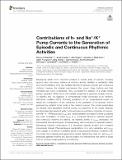Files in this item
Contributions of h- and Na+ /K+ pump currents to the generation of episodic and continuous rhythmic activities
Item metadata
| dc.contributor.author | Sharples, Simon A. | |
| dc.contributor.author | Parker, Jessica | |
| dc.contributor.author | Vargas, Alex | |
| dc.contributor.author | Milla-Cruz, Jonathan J. | |
| dc.contributor.author | Lognon, Adam P. | |
| dc.contributor.author | Cheng, Ning | |
| dc.contributor.author | Young, Leanne | |
| dc.contributor.author | Shonak, Anchita | |
| dc.contributor.author | Cymbalyuk, Gennady S. | |
| dc.contributor.author | Whelan, Patrick J. | |
| dc.date.accessioned | 2022-02-22T15:30:21Z | |
| dc.date.available | 2022-02-22T15:30:21Z | |
| dc.date.issued | 2022-02-04 | |
| dc.identifier | 277967945 | |
| dc.identifier | c9f2d10f-6fe4-4327-91fd-c6ebcb7bac39 | |
| dc.identifier | 85124972560 | |
| dc.identifier | 000760222900001 | |
| dc.identifier.citation | Sharples , S A , Parker , J , Vargas , A , Milla-Cruz , J J , Lognon , A P , Cheng , N , Young , L , Shonak , A , Cymbalyuk , G S & Whelan , P J 2022 , ' Contributions of h- and Na + /K + pump currents to the generation of episodic and continuous rhythmic activities ' , Frontiers in Cellular Neuroscience , vol. 15 , 715427 . https://doi.org/10.3389/fncel.2021.715427 | en |
| dc.identifier.issn | 1662-5102 | |
| dc.identifier.other | Jisc: 98410 | |
| dc.identifier.other | ORCID: /0000-0003-2316-1504/work/108919890 | |
| dc.identifier.uri | https://hdl.handle.net/10023/24926 | |
| dc.description | Authors acknowledge studentships from the Natural Sciences and Engineering Research Council of Canada (NSERC-PGS-D: SS); Alberta Innovates (AIHS: SS and AL); Hotchkiss Brain Institute (SS and AL); and the Faculty of Veterinary Medicine (LY). This research was supported by grants from the Canadian Institute of Health Research (PW); an NSERC Discovery grant (PW); and National Institutes of Health, National Institute of Neurological Disorders and Stroke 1 R21 NS111355 (GC and Ronald L. Calabrese). | en |
| dc.description.abstract | Developing spinal motor networks produce a diverse array of outputs, including episodic and continuous patterns of rhythmic activity. Variation in excitability state and neuromodulatory tone can facilitate transitions between episodic and continuous rhythms; however, the intrinsic mechanisms that govern these rhythms and their transitions are poorly understood. Here, we tested the capacity of a single central pattern generator (CPG) circuit with tunable properties to generate multiple outputs. To address this, we deployed a computational model composed of an inhibitory half-center oscillator (HCO). Following predictions of our computational model, we tested the contributions of key properties to the generation of an episodic rhythm produced by isolated spinal cords of the newborn mouse. The model recapitulates the diverse state-dependent rhythms evoked by dopamine. In the model, episodic bursting depended predominantly on the endogenous oscillatory properties of neurons, with Na+/K+ ATPase pump (IPump) and hyperpolarization-activated currents (Ih) playing key roles. Modulation of either IPump or Ih produced transitions between episodic and continuous rhythms and silence. As maximal activity of IPump decreased, the interepisode interval and period increased along with a reduction in episode duration. Decreasing maximal conductance of Ih decreased episode duration and increased interepisode interval. Pharmacological manipulations of Ih with ivabradine, and IPump with ouabain or monensin in isolated spinal cords produced findings consistent with the model. Our modeling and experimental results highlight key roles of Ih and IPump in producing episodic rhythms and provide insight into mechanisms that permit a single CPG to produce multiple patterns of rhythmicity. | |
| dc.format.extent | 21 | |
| dc.format.extent | 10677958 | |
| dc.language.iso | eng | |
| dc.relation.ispartof | Frontiers in Cellular Neuroscience | en |
| dc.subject | Episodic rhythms | en |
| dc.subject | Central pattern generator | en |
| dc.subject | Spinal cord | en |
| dc.subject | Rhythmicity | en |
| dc.subject | Dopamine | en |
| dc.subject | Bursting | en |
| dc.subject | Locomotor | en |
| dc.subject | Elliptic episodic bursting | en |
| dc.subject | RC0321 Neuroscience. Biological psychiatry. Neuropsychiatry | en |
| dc.subject | DAS | en |
| dc.subject.lcc | RC0321 | en |
| dc.title | Contributions of h- and Na+ /K+ pump currents to the generation of episodic and continuous rhythmic activities | en |
| dc.type | Journal article | en |
| dc.contributor.institution | University of St Andrews. Organic Semiconductor Centre | en |
| dc.contributor.institution | University of St Andrews. School of Psychology and Neuroscience | en |
| dc.identifier.doi | 10.3389/fncel.2021.715427 | |
| dc.description.status | Peer reviewed | en |
This item appears in the following Collection(s)
Items in the St Andrews Research Repository are protected by copyright, with all rights reserved, unless otherwise indicated.

